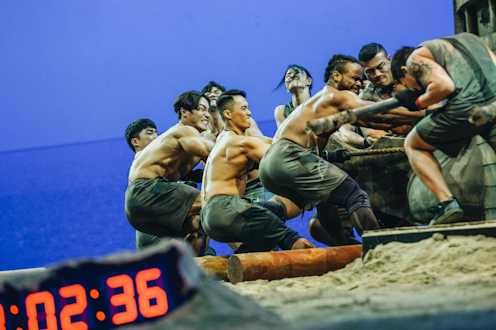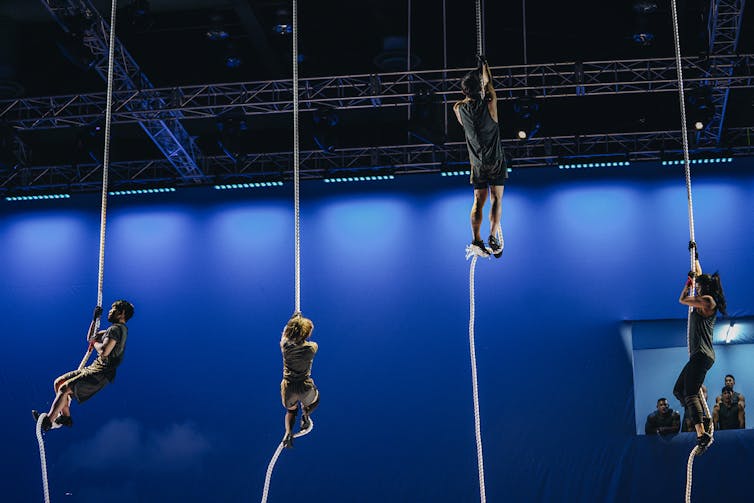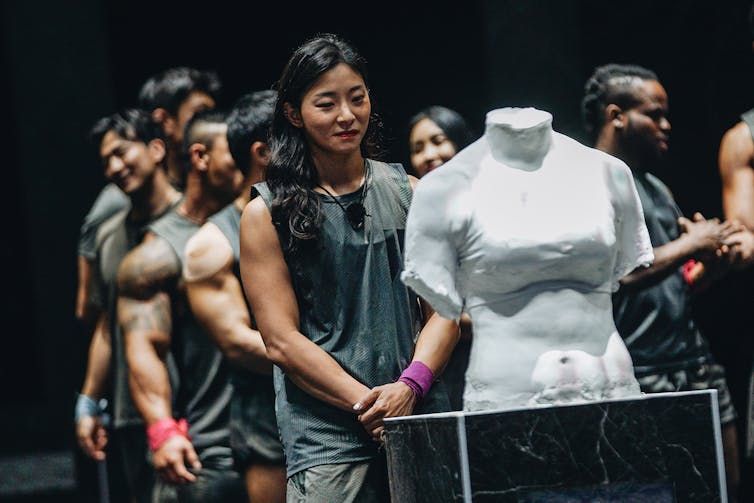
South Korea’s latest Netflix sensation, the reality series Physical: 100, appears to be heavily influenced by the pop-culture phenomenon Squid Game.
The series is another variant of the survival game, a common reality TV format and, as in the fictitious Squid Game, a large prize will eventually go to the person who wins the final game. However, this prize is not an unimaginable amount (ultimately around US$35 million in Squid Game) but a more modest US$250,000 – and importantly does not depend on and increase with the gory elimination of players.
The premise of the series is that 100 people who share a common interest in sports or physical fitness have been invited to take part in a sequence of quests. They come from all walks of life, are male and female, have a wide range of body sizes and shapes, and are aged anywhere between 20 and 50.
The object of the competition is to find the person with the best physicality, an undefined notion that does not necessarily mean the strongest, fastest or best-looking, as some competitors assume.
The broadness of this premise contributes to the success of the series, which within two weeks of release rose to the number-one global ranking on Netflix, the first Korean reality series to achieve this position.
A more wholesome show than Squid Game
Deliberate allusions to Squid Game do invite a comparison between the shows beyond simply both being on Netflix and from South Korea. The physical layout of the setting, the masked anonymity of the show’s attendants, and the 50% elimination rate in the first three quests are all apt comparisons.
But in Physical: 100 the prevailing theme is the human capacity for endurance, and any physical violence in one-on-one matches is part of the sport, rather than for brutality.
A key contrast with Squid Game is the greater and more active role assigned to women, who are depicted through a range of physical careers such as boxers, body-builders or fitness models, and through diverse body types. Wrestlers like Jang Eun-sil have larger frames and developed muscularity, in contrast to fitness YouTuber Shim Eu-ddeum, who is quite petite. These women are far from the opportunistic or sacrificial roles assigned to women in Squid Game.
A second strategy is the use of an internal audience. Unlike Squid Game’s audience of cold-blooded capitalists, Physical: 100’s internal audience consists of the other contestants, who cheer on and express admiration for the skills and ingenuity of their fellows.
The camaraderie among the contestants extends to the one-on-one “death match” contests: players regularly express humility in defeat and declare they will now support their victorious opponent, or they express generosity in victory. Even during a match, they will acknowledge a good move, as when rugby player Jang Seong-min, repeatedly thrown by a female wrestler, picks himself up and flashes her an appreciative smile.
Particular respect is also shown towards older contestants, such as Choo Sung-hoon (47), a Mixed Martial Arts boxer. He is treated with great honour, and younger Shin Don-guk (41) challenges him to show this honour – when defeated, Shin kneels before Choo and touches his forehead to the ground.

Greek gods and twisted fairytales
Where Squid Game took familiar children’s games and gave them a dark twist to form the challenges, Physical: 100 uses a Classical Greek frame instead. This evokes the reverence the Greeks held for the ideal body and athletic endeavour. The result is that attention is focused not on any past hardship suffered by the participants, but on the capabilities and aesthetics of the human body.
Although the contest is ostensibly to find the best body with the strongest physicality, the series persistently shows that no two bodies are alike and all are beautiful in their own ways.
The drama opens in an auditorium where plaster torsos are set out in concentric circles. These are casts of the bodies of the 100 participants who begin the contest. To ensure viewers are correctly cued, one of the newly entered participants remarks, “It’s like entering a Greek temple.” The point is reinforced by a sculpture of the Greek goddess of hunting, Artemis, recognisable by her iconic bow.

High stakes and large egos
Where the participants in Squid Game are usually depicted as being without hope, those in Physical: 100 have more agency over their lives, by a capacity either to shape their own bodies or to cultivate particular skills, or both.
Physical attributes also function in different ways, so that simple strength is often not sufficient. For example, diverse abilities are key to the outcomes of matches between teams in Quest 2, Sand Moving (Episodes 4–5). In its representation of underdog victories, this sequence invites comparison with the Tug of War sequence in Squid Game.

In the first match, the presumed weaker team, with the only female leader (wrestler Jang Eun-sil) and predominantly female members, triumphs through more effective teamwork. In this contest, teams compete by bagging sand and carrying it across a suspension bridge they need to first complete. In another underdog victory, stuntwoman Kim Da-yeong gives her team a winning edge by carefully building a safe and secure bridge, because she knows the importance of safe equipment. In contrast, the opposing team loses time because their bridge is built too hastily and begins to disintegrate as they clatter across it.
Strength or speed or other physical skills are celebrated, but in the end, strategy and teamwork is often equally or more important.
As one competitor puts it, “If you did your best, you accept the result.” Herein is arguably a major contrast with Squid Game: the contestants compete for high stakes, and often have large egos, but attract viewer empathy as they come to terms with their limitations and evidence a shared humanity.
To be human is to accept failure along with success, and this is arguably the series’ strongest critique of the pessimism of Squid Game.
Sung-Ae Lee does not work for, consult, own shares in or receive funding from any company or organisation that would benefit from this article, and has disclosed no relevant affiliations beyond their academic appointment.
This article was originally published on The Conversation. Read the original article.







